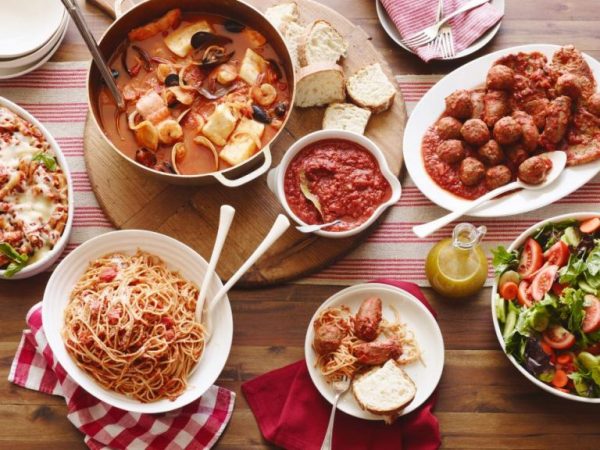Italian Cuisine
Italian cuisine ranks alongside French cuisine in terms of worldwide fame. Pizza and pasta have become world dishes, which are not only cooked in restaurants, but also by most home cooks. No matter where they grow up in Europe, all children are familiar with Italian dishes, such as pizza Margherita and spaghetti bolognese.
Characteristics of Italian cuisine
Italian cuisine is gaining worldwide popularity due to its wonderful variety of flavors, but what are its most important characteristics?
Italian cuisine is one of the oldest in the world, whose recipes are passed down from generation to generation and reflect the differences between each of its regions. Most of their dishes follow strictly traditional ingredients , though some, such as pizzas or pasta, are recreated to fit more successfully into our modern personality.
If you think of Italian cuisine, pizza and pasta come to mind immediately, but there are many more dishes, such as p isoto, osbubucco, Florentine steak, and incredible desserts, such as tiramisu, profiteroles or pudding , that complement the picture of the superb Italian cuisine that is included in the Mediterranean diet and is considered one of the healthiest in the world. Among the foods that make it are those like echin, wheat flour and rice.
Italian cuisine is synonymous with freshness. Of all the most typical dishes in this culinary style that are cooked, they are always pleasantly fresh, demonstrating their refined taste with each bite.
Italian breakfast is light and usually consists of a cup of coffee (warm milk for children) and cookies (cookies), bread or rolls. Alkarsa croissants or other fillings are also popular.
Spaghetti is a staple in the Italian diet. They are served in many different ways: from ravioli, which are small squares filled with meat, cheese or vegetables, to fettuccine, which is noodles on wide strips. All this is well accompanied by a wide selection of sauces, one of them is the famous Bolognese – prepared with tomatoes, mince, pork, veal or chicken livers, while other types are salmon or mushrooms.

The typical Italian meal consists of three dishes, but when the guests have guests or eat in a restaurant, it is normal to start with an entree followed by a pasta dish , mainly meat or fish, as well as dessert or some cheese. Salad is often served after the main course . Italy is an important wine producer. This is the drink that usually accompanies a salad.
Lunch is eaten between 11:30 and 14:00; dinner is around 7.30pm, but in Sicily and other southern regions it is quite common to have dinner at 10.30pm.
Most of the foods that many of us consider Italian, like spaghetti and pizza, come from central Italy. In northern Italy, fish, potatoes, rice, sausages, pork and various types of cheese are the most common ingredients.
Spaghetti and tomato dishes are popular, as are many types of stuffed pasta, such as polenta and risotto. To the south, tomatoes dominate the dishes. They are served fresh or cooked in different types of sauces. Southern cuisine includes peppers, olives, olive oil, garlic, artichoke, eggplant and ricotta cheese.
Regional Cuisine occurs with a huge variety of surprisingly tasty dishes that paint a picture where you can see various kinds h Nittel aspects of each region. In the vastness of gastronomic resources we can find the following works of culinary art:
Aperitivo
After a long day, Italians like to go to the local bar for a traditional “aperitif” accompanied by a few light meals. But this is not an excuse to drink to oblivion.
The operative time is usually between 19:00 and 21:00 and there are three important digestive goals. The first is that Italians can relax and meet people after work. The second is to start their digestive metabolism with a tingling, slightly bitter tonic (not an unpleasantly sweet cocktail) to boost their appetite before dinner. And the third to slowly open their stomach and prepare it for the typically typical Italian dinner . Without an aperitif to prepare the digestive process, the Italians believe that they run the risk of digestive problems. So do not miss out on this wonderful Italian custom.
Coffee
There is nothing better for coffee drinkers than enjoying a cup of coffee in Italy. Just remember that Italian coffee is not the same as coffee at our local Starbucks. Although there are dozens of species and their names may sound the same as those you get used to, they are rarely what you think – those you have seen in the movies or that is served in your country. For example, if you order “latte” in Italy , they will just serve you a glass of milk.
Vegetables and fruits
Vegetables are an important part of Italian cuisine, especially because of the aromas and flavors that convey the dishes. As for fruits, their use ranges from eating them as jellies to using them in desserts and cake decorations.
Meat and fish
Italy offers a wide variety of meats and fish needed for a variety of dishes, most notably stews or beef. Within this are sausages and prosciutto, which is nothing more than ham, mortadella or salami . For fish, the most popular area for it is Sicily.
Wines
Italy is a rich wine producer known for its aroma and quality. It will not be difficult to find some of them at the wineries. They include white and red wines, and their names are usually determined by the place of their production.
Pizzas and breads
Undoubtedly, the most famous dish in Italian cuisine is pizza , which with its innumerable types and flavors, remains one of the favorite and most famous pasta in the world. It consists of a pastry with tomato sauce, mozzarella (and / or other types), peppers, mushrooms, some sausage and aromatic spices.
Italy also presents a variety of breads in different parts of the country.
The story of pizza
The pizza was invented by workers in Naples, southern Italy, when the province, between 1700 and early 1800, was designed as a trading hub for the construction of its ports. It is these workers who, in an effort to eat something simple, simple and cheap, invent pizza – thin bread, as an ideal base on which to put different products, usually ingredients that would otherwise be thrown away. Shortly afterwards, this unpretentious breakfast began to be sold informally on the streets of the city.
However, for a long time nowhere else in the country do they like this dish, so their pizza remains a creation only within Naples . In 1889, King Umberto I and Queen Margherita , the first kings of Italy, visited the city. Tired of eating French dishes, they taste the pizza. The queen liked the mozzarella so much that in her honor its producers called it Margherita pizza.
Margherita Maria Teresa Giovanna di Savoia
It was not until 1940, when one of the migration waves to the United States began, that pizza became known in New York and other border cities such as Boston and Chicago. After World War II, pizza gained notoriety among the American people not as a foreign meal, but as a food for the nation, labeling it as “fast food .”
The love of pizza spread rapidly , crossed borders and seas, and finally arrived again in Italy, which, seeing that it had become a popular dish around the world, decided to accept this simple and at the same time delicious culinary creation as its own.
Currently, 95 percent of the world’s population consumes pizza, which is why the pizza industry is estimated at $ 35 billion. This dish is so heavily embedded in the economy and the mass culture that the US sets October for pizza month – these are 31 days devoted to this crunchy, flavorful and delicious pasta.

There are no comments